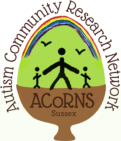Our autism reading group this month focused on the topic of gender diversity and autism. The current literature suggests that people who don’t identify with the gender assigned at birth are 3-6 times more likely to be autistic. Our discussion was really interesting and focused around 4 main areas:
How can education surrounding gender identity be improved for autistic people particularly?
We started by discussing the topic of masking – one autistic person shared how they learnt to mask from a young age and did this to cover both their autism and their feelings about their gender identity. They explained how, just as they learned to make eye contact to follow social norms, they also learned to sit and dress like a girl.
We thought about the power uniforms play in school in creating discomfort for autistic people questioning their  gender identity. Uniforms can reinforce gender stereotypes as well as causing significant sensory issues for some autistic students. Many primary and secondary schools have rigid rules on this, compared to settings such as colleges. We wondered why this is so necessary to learning: surely improving comfort would create a better school experience. We discussed the broader issue of some of society not accepting people who do not conform to traditional norms, be this autism or gender identity. It can lead to people feeling they are not safe to be themselves. We, therefore, felt that it is important not only to educate and support an individual student on topics surrounding gender but for more understanding in wider society.
gender identity. Uniforms can reinforce gender stereotypes as well as causing significant sensory issues for some autistic students. Many primary and secondary schools have rigid rules on this, compared to settings such as colleges. We wondered why this is so necessary to learning: surely improving comfort would create a better school experience. We discussed the broader issue of some of society not accepting people who do not conform to traditional norms, be this autism or gender identity. It can lead to people feeling they are not safe to be themselves. We, therefore, felt that it is important not only to educate and support an individual student on topics surrounding gender but for more understanding in wider society.
How can we help autistic people to understand and feel comfortable with their gender identity?
To start this discussion first a group member raised how as well as peer awareness and celebration of difference, we should also work with students 1-1 to help them to feel comfortable in who they are.
Some autistic individuals can have disrupted identities: it could help to support such people to find what makes them ‘them’ and supporting a feeling of belonging and being their true selves.
How can clinicians/caregivers adapt their practice around gender screening and autism?
Group members expressed that they felt there is still a long way to go in terms of autistic stereotypes – for example, the idea that autistic girls mask is true for some, but not others, and might also be true for some boys. Could it be that people who do not present in the typical way for their gender can find it harder to get a diagnosis of autism?
 This led us to a discussion of trans-diagnostic screening: there is overlap not just between autism and gender identity questions, but also with chronic health conditions. Perhaps these other conditions could prompt screening for autism? For example, GPs could ask about common features of autism (friendships, sense of belonging) for people experiencing hypermobility or chronic pain: this could lead to prompter identification of autism.
This led us to a discussion of trans-diagnostic screening: there is overlap not just between autism and gender identity questions, but also with chronic health conditions. Perhaps these other conditions could prompt screening for autism? For example, GPs could ask about common features of autism (friendships, sense of belonging) for people experiencing hypermobility or chronic pain: this could lead to prompter identification of autism.
What are the service implications for higher levels of gender dysphoria and gender diversity in the autistic population?
One group member expressed that in their experience some practitioners see helping autistic gender diverse people as too complicated so do not see them or pass them on to someone else. We asked whether we really always need the classic, universal screening process or if we could remove these barriers. We really need to find a way to speed up the discussion around this area and potentially introduce a fast-track system. When it comes to accessing hormone replacement gender-confirming options it can be hard to get an autistic person to explain the emotional pain they are in – as result they can go unnoticed until it is too late for these time-sensitive treatments. A group member likened it to having a high physical pain tolerance and using different words to express pain, this can result in it being a lot harder to access treatments. We need to allow the autistic population to use metaphors to explain how they feel. One group member used the metaphor of feeling like an ‘alien in a human suit’. In their experience doctors don’t pick up on what these mean and if they had been questioned further about these feelings, they could have received support sooner. The most important thing is that changes to the screening processes must be done in collaboration with and led by autistic people.
to explain how they feel. One group member used the metaphor of feeling like an ‘alien in a human suit’. In their experience doctors don’t pick up on what these mean and if they had been questioned further about these feelings, they could have received support sooner. The most important thing is that changes to the screening processes must be done in collaboration with and led by autistic people.
There is also a difference between how children express themselves and what they can understand. It is important that people who are working with gender diverse autistic people know the individual, for example, if the autistic person does talk are they also able to comprehend everything that is being said? This could be improved by talking more directly or having more time. One individual mentioned the power they find in writing what they want to say down before speaking about it, so they make sure everything they want to say is shared. We need more flexible systems with more space for difference.
 We then moved on to discuss the range of different resources currently available to inform and educate about gender diversity. It was highlighted in the literature that only a minority of resources are autism-friendly. We need more resources available to young people which need to be more inclusive of how they might feel. Pictures and graphics give alternative formats for people with different levels of language – a good example of this is the use of comics.
We then moved on to discuss the range of different resources currently available to inform and educate about gender diversity. It was highlighted in the literature that only a minority of resources are autism-friendly. We need more resources available to young people which need to be more inclusive of how they might feel. Pictures and graphics give alternative formats for people with different levels of language – a good example of this is the use of comics.
Found this interesting? Want to join our next meeting? Email: acorns@sussex.ac.uk to join the mailing list.
Links:
